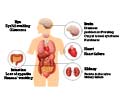Alzheimer's gradually destroys the ability to reason, remember, imagine and learn. It is marked by abnormal plaques and neurofibrillary tangles of brain cells.

- Dementia develops when amyloid builds up in neurons in the brain.
- It is now found that amyloid buildup in brain blood vessels also occurs in dementia.
- The discovery may help develop new diagnostic methods and therapy for dementia.
Lead investigator William Van Nostrand, PhD, a Professor in the Department of Neurosurgery, says the findings stem from collaborative work with Steven Smith, PhD, a Professor in the Department of Biochemistry & Cell Biology. They, along with colleagues, mapped out the structural signature of amyloid that accumulates in brain blood vessels and compared it to the known structure of amyloid that accumulate in plaque around brain neurons.
The team found that the subunits of the amyloid that accumulates in vessels line up uniquely and in alternating patterns, which presents in a near opposite pattern of amyloid buildup in plaque around neurons.
“This discovery may help guide us to the development of a new diagnostic tool or therapeutic intervention for dementia patients who display this vessel pathology,” summarized Dr. Van Nostrand.
They hypothesize that the unique structure of this brain blood vessel amyloid could promote different pathological responses, ie, inflammation, which likely contributes differently to cognitive impairment and dementia than neuron amyloid.















